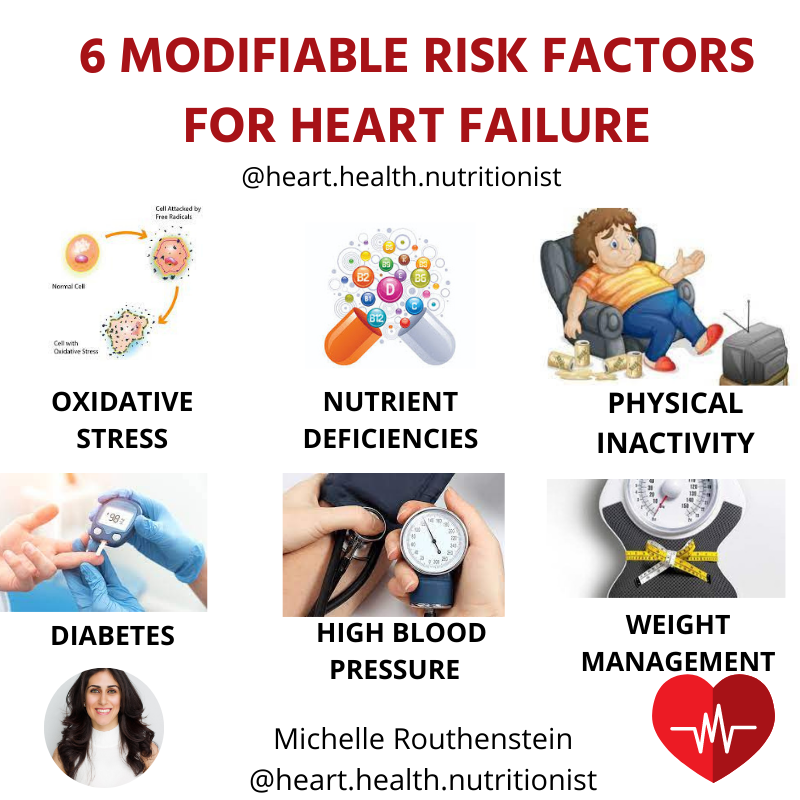Understanding how ejection fraction impacts your heart’s overall function can help you prevent complications from heart failure. In this article, I’ll cover the basics of heart failure, the difference between heart failure with preserved versus non-preserved ejection fraction, and important risk factors and symptoms of heart failure. I will also discuss how to increase ejection fraction naturally for improved heart function.

What is Heart Failure?
Heart failure is not a singular disease but a clinical syndrome that occurs due to a structural or functional impairment of the heart. This condition results in increased pressure within the heart or inadequate ejection of blood from the left ventricle of the heart.
The left ventricle is a chamber of the heart located at the bottom left portion of the heart. Its role is to pump oxygenated blood throughout the body. In the case of heart failure, the left ventricle gradually weakens. This means the heart must work harder to pump oxygenated blood from the lungs to the rest of the body.1
Heart Failure with Preserved EF vs Non-Preserved EF
Heart failure is diagnosed by a doctor based on your medical history, physical exam, and imaging tests. One of the main tests used to diagnose heart failure is an echocardiogram, an imaging test that uses ultrasound to take images of the heart muscle and valves. This test also measures ejection fraction and the movement of blood through the heart.
Ejection fraction (EF) is a measurement that describes how much oxygenated blood the left ventricle pumps out with each contraction. To calculate EF, the stroke volume (the volume of blood ejected from the left ventricle during systolic contraction) is divided by end-diastolic volume (the volume of blood in the left ventricle just before systole contraction). This number is then multiplied by 100 to get a percentage.
For healthy adults, the normal ejection fraction is between 55% to 75%. In diagnosed heart failure, ejection fraction is used to assess the severity of heart failure with reduced ejection fraction (HFrEF). EF levels below 40% are considered HFrEF, with a lower percentage indicating more severe heart failure. Levels between 40-55% are considered mildly impaired.
In approximately 50% of all heart failure cases, heart failure can occur without significant reductions in ejection fraction. According to recent guidelines from the American College of Cardiology (ACC) and the American Heart Association (AHA), heart failure with preserved ejection fraction is when the left ventricular ejection fraction is greater than or equal to 50% yet there is impaired diastolic function.2
One factor that contributes to diastolic dysfunction in heart failure with preserved ejection fraction is stiffness within the heart muscle. When heart muscle is too stiff, it makes it difficult for the heart to relax and allow blood to flow through its chambers. As a result, the heart muscle increases the pressure it uses to push blood through the heart and can cause fluid retention in the lungs and legs. 3
Classification of heart failure by ejection fraction:
- EF 55% to 75%: Normal heart functioning
- EF ≥ 50% w/ impaired diastolic function- heart failure with preserved ejection fraction
- EF 41% to 49%: heart failure with mildly reduced EF (HFmrEF)
- EF ≤ 40%: HFrEF
Causes of Heart Failure
Heart failure can be caused by both cardiac-related conditions and cardiac dysfunctions due to noncardiac health conditions.
Heart conditions that can cause heart failure include cardiomyopathy, coronary artery disease, high blood pressure, valve disease, arrhythmia, infiltrative cardiac disease, and congenital heart disease.
Common non-cardiac causes of heart failure include autoimmune diseases, endocrine and metabolic diseases, vitamin deficiencies, substance use, viral infections, and cardiotoxicity from medications.4

Who is at risk for heart failure?
Approximately 6.5 million adults in the United States have heart failure, with specific populations at a higher risk for developing this syndrome.2
The following groups are at risk for heart failure:
- Adults ages 65 or older
- Individuals with a family history of heart failure
- People with chronic conditions
- People with a history of high blood pressure, heart attack, or coronary artery disease
- African Americans
Symptoms of Heart Failure
Recognizing the symptoms of heart failure early on can prevent hospitalization and make it easier for you to take control of your heart health. Common symptoms of heart failure include:
- Shortness of breath while lying down or during activity
- Reduced exercise tolerance and longer exercise recovery
- Fatigue and weakness
- A rapid or irregular heartbeat
- Abdominal pain
- Bloating
- Swollen ankles
Less common symptoms of heart failure may include loss of appetite, dizziness, confusion, depression, syncope, and wheezing.4
How to Increase Ejection Fraction Naturally
Certain lifestyle changes can help you increase ejection fraction naturally in combination with personalized recommendations from your doctor and a cardiac dietitian.
Traditional advice on increasing your ejection fraction and preventing progression of heart failure usually centers on reducing sodium intake and limiting fluid intake. However, there are additional ways that you can increase your ejection fraction naturally.
Manage Blood Sugar and Insulin Resistance
Heart failure is associated with insulin resistance. Managing blood sugar may be important, even if you have not been officially diagnosed with diabetes, but may be experiencing symptoms of insulin resistance. When excess blood sugar levels are in the bloodstream, it can damage blood vessels and cause vascular disease, leading to dysfunctions in systolic or diastolic function, and negative left ventricular remodeling. Research also shows that insulin resistance can lead to progression and decline of heart failure. 5, 6
To protect your heart health, follow an eating pattern that minimizes spikes in blood sugar and supports normal insulin sensitivity.
- Spread your carbohydrate intake evenly throughout the day.
- Make half of your plate non-starchy vegetables. Non-starchy vegetables are also rich in vitamins and antioxidants that can protect against inflammation caused by diabetes.
- Increase the amount of soluble fiber in your diet to increase insulin sensitivity. Some foods that are major sources of soluble fiber include ground flax seeds, Brussels sprouts, artichokes, and avocados.7
- Speak with a trained registered dietitian or doctor about individualized daily carbohydrate needs to meet your lifestyle instead of following generic carbohydrate recommendations.
Choose Anti-Inflammatory Foods
Oxidative stress and inflammation are common with heart failure and the conditions that contribute to heart failure. Excess oxidative stress and inflammation can be present when living with a heart condition, and can be exacerbated by under or over exercising, high stress levels, poor sleep, smoking, and unbalanced nutrition that is rich in saturated fat, refined sugars and processed foods. 8, 9
What we add into the diet is equally important. Adding in antioxidant and phytochemical-rich foods, spices, and herbs to your diet can help improve blood vessel health and optimize blood flow. Various phytochemicals found in the diet are shown in research to be beneficial for heart failure. For example, blueberries are rich in phytonutrients including flavonols and polyphenols that protect against cardiovascular disease and other chronic diseases. The anthocyanins in blueberries are known to reduce inflammation, help reduce insulin resistance, support healthy fat metabolism, and support normal heart function. 10 Another example is cocoa flavonols from dark chocolate or cocoa powder are consistently associated with a reduced risk of heart failure, stroke, and overall cardiovascular disease incidence and risk. A 2021 review of studies shows that cocoa flavonols support improvements in blood pressure, arterial stiffness, and cholesterol levels. 11
Consume a Nutritionally Adequate Diet
Research finds that micronutrient and macronutrient deficiencies are more common in adults with heart failure and may contribute to worse health outcomes. In this particular study, it found above 20% of individuals with heart failure have low intake of vitamin A, calcium, magnesium, selenium, and iodine and up to 75% having low intake of vitamin D. 12 Other studies show that the prognosis of heart failure with reduced fraction is poor when an iron deficiency is present, and it is present in above 59% of individuals with heart failure. 13, 14
Factors that contribute to nutrient deficiencies in heart failure include diuretic use, increased inflammation, reduced appetite, inadequate nutrient absorption, and changes in metabolism. 15 High quality diets can provide the nutrients needed in order to reduce your risk of heart disease. Focus on a diet containing adequate amounts of heart-healthy vegetables and fruits, whole grains, heart healthy fats, and lean protein. To support your gut health and reduce inflammation, choose foods that are rich in prebiotics and probiotics. Limit your consumption of added sugars and sugar-sweetened beverages, as well as red meat and highly processed meats. 16
Consulting a registered dietitian who specializes in cardiovascular disease can give you the support you need and helps provide you with individualized recommendations to identify and correct nutrient deficiencies, and optimize cardiovascular function.
Regular Exercise
Being sedentary increases mortality risk in heart failure patients. Not only can exercise protect against heart failure, but it can also help those with a diagnosis of heart failure strengthen their heart and slow the progression of heart failure. Studies find that consistent moderate-intensity exercise training can improve cardiorespiratory fitness, vascular stiffness, and cardiac structure and function.17
Exercise needs to be gauged and individualized based on your medical history, and your exercise capacity. Your doctor or dietitian can help make recommendations about the type and duration of exercise that might be best for you.
Smoking Cessation
Smoking increases heart failure risk and may contribute to ejection fraction decline by increasing systolic and diastolic blood pressure, pulmonary artery resistance, oxidative stress, and carbon monoxide exposure. It is also a risk factor for left ventricular hypertrophy, systolic dysfunction, and increased hospitalization from heart failure.18
If you smoke, it is essential to speak to your doctor about quitting.
Take Control of Your Health
If you have reduced ejection fraction or are at risk for heart failure, joining a heart health optimization program and supportive community can help. I am a registered dietitian with years of experience in heart health optimization care and have successfully helped thousands of heart disease warriors learn how to manage their health.
I offer 1 on 1 personalized services to help you optimize your heart function, achieve your specific goals, and stop the progression of heart failure through science-based, personalized nutrition. You can improve your ejection fraction naturally with the right tools and support.
Client Success Stories:
A very kind 40-year-old woman came to see me because she had heart failure with a preserved ejection fraction, an enlarged heart, and was confused on what to eat. Her doctor said she needed to lose weight, but did not offer any other guidance. One of the main symptoms my client wanted to address was her shortness of breath that can impacted her quality of life.
She joined my VIP program and we created a realistic nutrition and lifestyle plan to help her achieve her goals and optimize her heart health. Given her shortness of breath, particularly when she walked, we started with nutrition optimization strategies.
In my initial assessment, it became apparent to me that she had several nutrient deficiencies that were caused by several factors: 1) she was on diuretics that can deplete magnesium, potassium and zinc – three essential nutrients for heart health, 2) she would alternate between constipation and diarrhea – a sign of underlying gut issues, 3) she had known iron deficiency which is very common in individuals with heart failure, but can decrease prognosis if not properly managed.
We focused on 3-4 habits in 2 week time period to achieve her goals realistically and sustainability. Within 1.5 months, she reported with a lot more energy than she ever had, she did not have shortness of breath at rest and was able to incorporate daily walks of about 30 minutes with ease, and she was having normal effective bowel movements! Within 3 months, she continued to maintain those achieved successes and also lost 10 pounds and 4.5 inches off her waist!
It is an honor to continue to work with her and I am so proud of her accomplishments!
———————————————————————————————————
I have to start off by saying that I love when my clients surprise me with how science-based nutrition impacts their life and their heart health!
I got a call the other day from a client’s wife whose husband completed my VIP program 2 months ago. She asked me to sit down and said “Michelle, my husband’s ejection fraction when he first started with you was 15%. Are you sitting? It is now 60%!
To give you some background, this client came to see me because 6 months ago he had just undergone triple bypass surgery (to open up the blockages in his arteries), and was fatigued and had shortness of breath upon exertion.
In the VIP program, we worked together to merge the science based nutrition and his lifestyle for optimal cardiovascular health. Our goal was to increase his energy, keep his stents patent, and improve his cardiovascular health. He gained tremendous energy over the course of a couple months, picked up running with medical clearance, had great improvements in his laboratory results and had a decrease in his statin and BP medications. But to see his heart gain so much more function (ejection fraction from 15% to 60%!) was just wow!
(For those who are unfamiliar, Ejection Fraction (EF) measures how much blood the left ventricle (the heart’s main pumping chamber) pumps out with each contraction.
A normal ejection fraction is between 55-70%. An ejection fraction of 50% is considered reduced. Lower than 40% is a sign of heart failure or cardiomyopathy).
It was a true pleasure to work with this family and I was so happy my client’s wife called me to share this news – it really made my day and filled me with gratitude for what I do!
To learn more about how we can work together in a 1 on 1 or a group setting, schedule a 15 minute complimentary discovery call here.
References
- Berman MN, Tupper C, Bhardwaj A. Physiology, Left Ventricular Function. [Updated 2021 Sep 20]. In: StatPearls [Internet]. Treasure Island (FL): StatPearls Publishing; 2022 Jan-. Available from: https://www.ncbi.nlm.nih.gov/books/NBK541098/
- McDonagh TA, Metra M, Adamo M, et al. 2021 ESC Guidelines for the diagnosis and treatment of acute and chronic heart failure [published correction appears in Eur Heart J. 2021 Oct 14;:]. Eur Heart J. 2021;42(36):3599-3726. doi:10.1093/eurheartj/ehab368
- Chi C, Liu Y, Xu Y, Xu D. Association Between Arterial Stiffness and Heart Failure With Preserved Ejection Fraction. Front Cardiovasc Med. 2021;8:707162. Published 2021 Aug 11. doi:10.3389/fcvm.2021.707162
- Heidenreich PA, Bozkurt B, Aguilar D, et al. 2022 AHA/ACC/HFSA Guideline for the Management of Heart Failure: A Report of the American College of Cardiology/American Heart Association Joint Committee on Clinical Practice Guidelines [published correction appears in Circulation. 2022 May 3;145(18):e1033]. Circulation. 2022;145(18):e895-e1032. doi:10.1161/CIR.0000000000001063
- Riehle C, Abel ED. Insulin Signaling and Heart Failure. Circ Res. 2016 Apr 1;118(7):1151-69. doi: 10.1161/CIRCRESAHA.116.306206.
- Pop-Busui R, Januzzi JL, Bruemmer D, et al. Heart Failure: An Underappreciated Complication of Diabetes. A Consensus Report of the American Diabetes Association. Diabetes Care. 2022;45(7):1670-1690. doi:10.2337/dci22-0014
- Dong Y, Chen L, Gutin B, Zhu H. Total, insoluble, and soluble dietary fiber intake and insulin resistance and blood pressure in adolescents. Eur J Clin Nutr. 2019;73(8):1172-1178. doi:10.1038/s41430-018-0372-y
- Senoner T, Dichtl W. Oxidative Stress in Cardiovascular Diseases: Still a Therapeutic Target? Nutrients. 2019 Sep 4;11(9):2090. doi: 10.3390/nu11092090.
- Tsutsui, H., Kinugawa, S., & Matsushima, S. (2011). Oxidative stress and heart failure. American Journal of Physiology. Heart and Circulatory Physiology, 301(6), H2181–H2190.
- Ma L, Sun Z, Zeng Y, Luo M, Yang J. Molecular Mechanism and Health Role of Functional Ingredients in Blueberry for Chronic Disease in Human Beings. Int J Mol Sci. 2018;19(9):2785. Published 2018 Sep 16. doi:10.3390/ijms19092785
- Martin MÁ, Ramos S. Impact of cocoa flavanols on human health. Food Chem Toxicol. 2021;151:112121. doi:10.1016/j.fct.2021.112121
- Martens P. The Effect of Iron Deficiency on Cardiac Function and Structure in Heart Failure with Reduced Ejection Fraction. Card Fail Rev. 2022 Mar 16;8:e06. doi: 10.15420/cfr.2021.26.
- Bistola V, Filippatos G. Vitamin B12 deficiency in heart failure: another “brick in the wall”. Hellenic J Cardiol. 2020;61(5):338-340. doi:10.1016/j.hjc.2020.11.002
- Alnuwaysir RIS, Hoes MF, van Veldhuisen DJ, van der Meer P, Beverborg NG. Iron Deficiency in Heart Failure: Mechanisms and Pathophysiology. J Clin Med. 2021 Dec 27;11(1):125. doi: 10.3390/jcm11010125.
- Cascino TM, Hummel SL. Nutrient Deficiencies in Heart Failure: A Micro Problem With Macro Effects?. J Am Heart Assoc. 2018;7(17):e010447. doi:10.1161/JAHA.118.010447
- Petersen KS, Kris-Etherton PM. Diet Quality Assessment and the Relationship between Diet Quality and Cardiovascular Disease Risk. Nutrients. 2021;13(12):4305. Published 2021 Nov 28. doi:10.3390/nu13124305
- Cattadori G, Segurini C, Picozzi A, Padeletti L, Anzà C. Exercise and heart failure: an update. ESC Heart Fail. 2018;5(2):222-232. doi:10.1002/ehf2.12225
- Kamimura D, Cain LR, Mentz RJ, et al. Cigarette Smoking and Incident Heart Failure: Insights From the Jackson Heart Study. Circulation. 2018;137(24):2572-2582. doi:10.1161/CIRCULATIONAHA.117.031912
